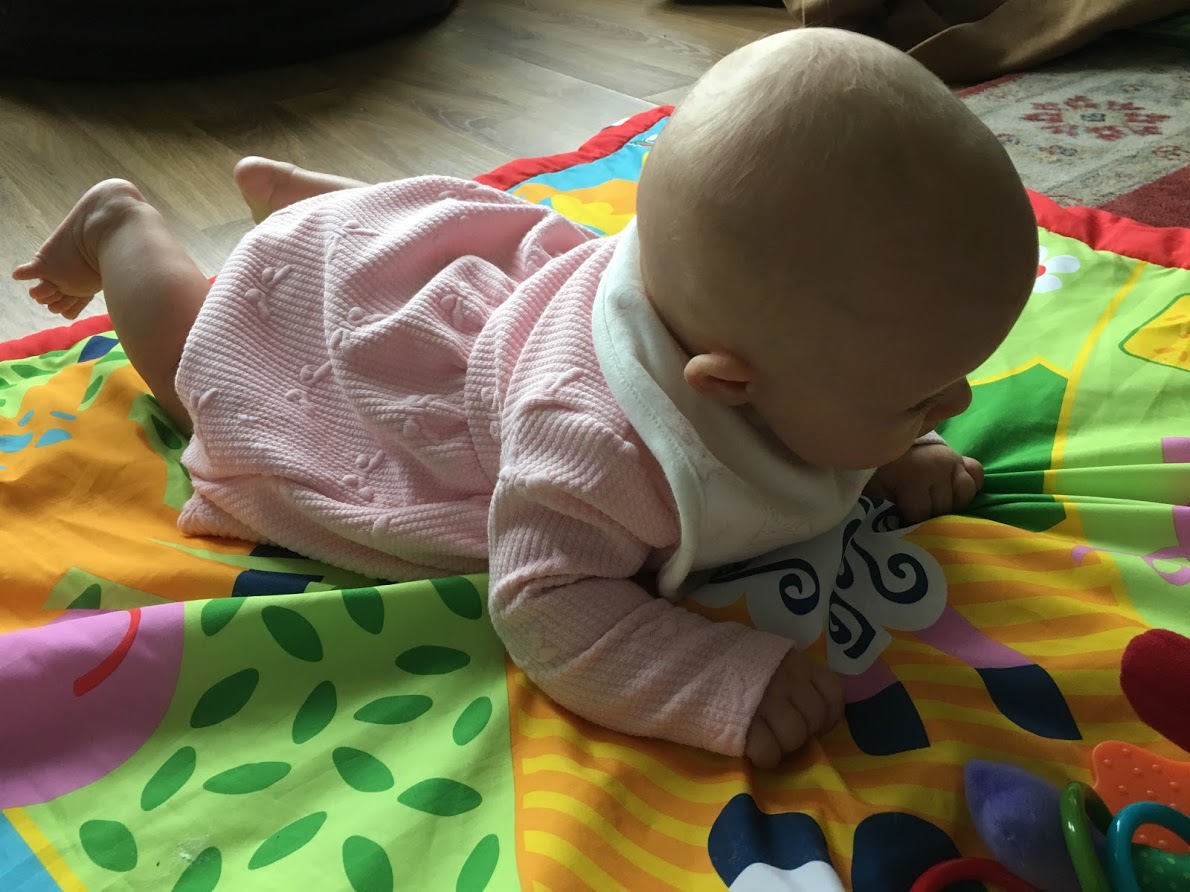Time on their tummy can be a really fun activity for your baby and is also a good way to bond. It helps your baby to develop their core strength and body awareness, as well as their motor skills, which will help them explore the world around them. It also helps your baby strengthen their neck, shoulder and trunk muscles, which they’ll need to support their head, sit up, crawl and eventually walk.
What is tummy time?
Tummy time is really simple to do. Just find a safe, clean and quiet space and place your baby on their tummy. It also helps when they can see your face so they feel safe and know it’s going to be fun! But remember to never put your baby to sleep on their tummy. Tummy time is an active time, not a time for sleeping. The saying ‘back to sleep, front to play’ can help you remember this.
Learning new physical skills can be difficult for babies and sometimes they may get upset and cry. This can be hard for you too, so remember to ask family and friends for support, or speak to your Health Visitor or Family Nurse for advice.
When should I start tummy time with my baby?
You can start doing tummy time with your baby as soon as they are born. But it’s good to keep it short to begin with, gradually increasing it as your baby gets more used to it.
If your baby is under 8 weeks old, you can find out more about their milestones at Ready Steady Baby.
Popping your baby’s head on a rolled up towel during tummy time can help. Here are some different ways to enjoy tummy time when you’re ready.
Tummy time tips
Tip #1: Tummy to tummy
Lie down on your back and place your baby tummy-to-tummy, or tummy-to-chest. The smell and warmth of you makes this a really comforting position to enjoy some together time.
Tip #2: Eye level
Your baby loves your face and voice. Stay at the same level (you on the floor, baby on the bed or sofa) and talk and sing to them. If you move your position a little, see if your baby will move their head to follow you.
Tip #3: Tummy to lap
This is a good way to settle a grizzly baby. Place your baby across your lap, making sure they’re supported at the bottom area. You can then talk, play or massage them.
Tip #4: Tummy-down carrying
For a little change, try carrying your baby around with their tummy down on your arm, rather than upright and snuggled against your body.
This video from NHSGGC has more tummy time tips and different positions you can try.
Can I still do tummy time after 3 months?
Even from 4-6 months, tummy time is a good thing to do. You can also make it more interesting and fun by:
- Placing some toys around your baby to encourage them to reach out to the front and side
- Putting some toys ahead of your baby to see if they try and move towards the toys
- Using a mat with different textures and colours for your baby to lie on will encourage them to reach out and feel
- Once your baby can lift their head on their own, help them to put their arms under their body to push up and look around
Download the Tummy Time Learning leaflet for more tummy time ideas to try at different ages.
How can I help my baby like tummy time more?
Some babies don’t like to be on their tummies at first as it’s quite hard work when their muscles are small and still developing. If it feels strange for your baby, you can help them by:
- Keeping tummy time short to begin with, and then slowly build it up
- Building tummy time into your daily routine so your baby knows it’s coming up and what will happen next
- Making sure your baby can see your face and talking to them gently.
This video from NHSGGC suggests ways you can encourage your wee one to enjoy tummy time more
Staying safe
When your baby starts to be able to roll, you will need to be extra cautious when doing tummy time on a sofa or bed. Make sure you always stay close to prevent them from rolling close to the edge. You should never leave your baby on their own when they’re doing tummy time.
Should I be worried?
If your baby’s head control is not improving by 6 – 8 weeks, please contact your Health Visitor or Family Nurse. Or if you have any other concerns at any stage of your baby’s development, you can also discuss this with your Health Visitor or Family Nurse. If your baby is premature and receiving follow up care, you can also get advice from your developmental team.
If you have twins, triplets or more they may take a bit longer to reach milestones, especially if they were born prematurely. It’s best to talk to your health visitor if you have any concerns. You can find out more about milestones for multiples on the Twins Trust website.
Learning new physical skills can be hard for babies and it’s normal for them to cry. If they get really frustrated, they can cry in an angry way and their faces can turn quite red. You might find this worrying, but as long as your baby is not having breathing difficulties, there is nothing to be alarmed about. Just try to comfort and settle your baby as normal.
 Activities & Play
Activities & Play Behaviour
Behaviour Childcare
Childcare Development & Growing Up
Development & Growing Up Family, Friends & Relationships
Family, Friends & Relationships Feeding Your Baby
Feeding Your Baby Food & Eating
Food & Eating Health & Safety
Health & Safety Mental Health & Wellbeing
Mental Health & Wellbeing Money & Work
Money & Work Online Behaviour & Safety
Online Behaviour & Safety Pregnancy & First Days
Pregnancy & First Days School & Education
School & Education Sleep
Sleep














 Family, Friends & Relationships
Family, Friends & Relationships
 Mental Health & Wellbeing
Mental Health & Wellbeing